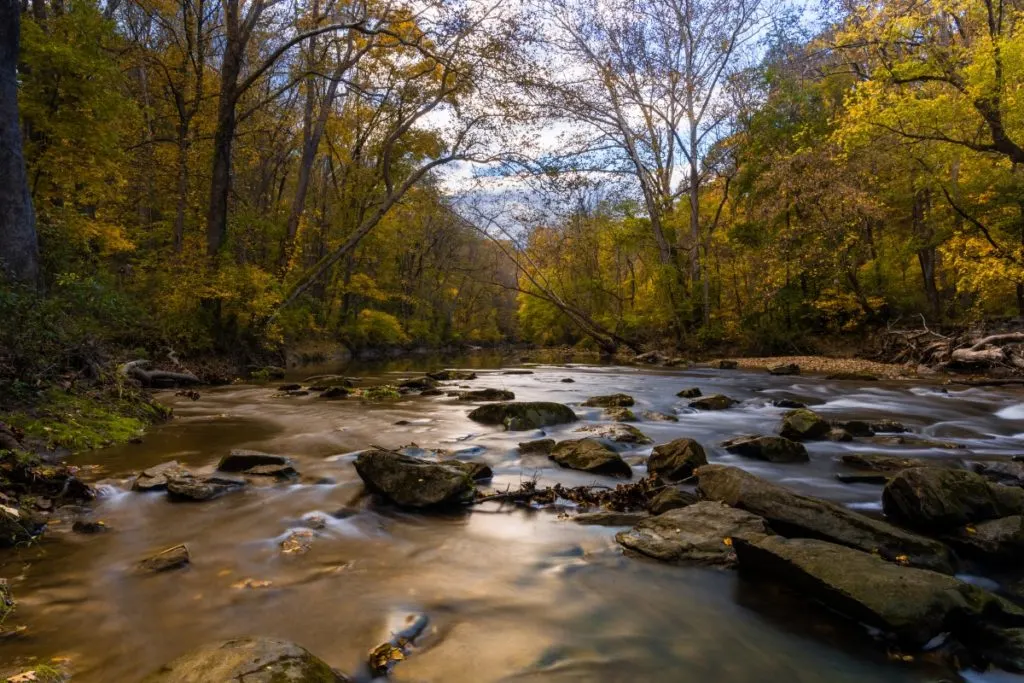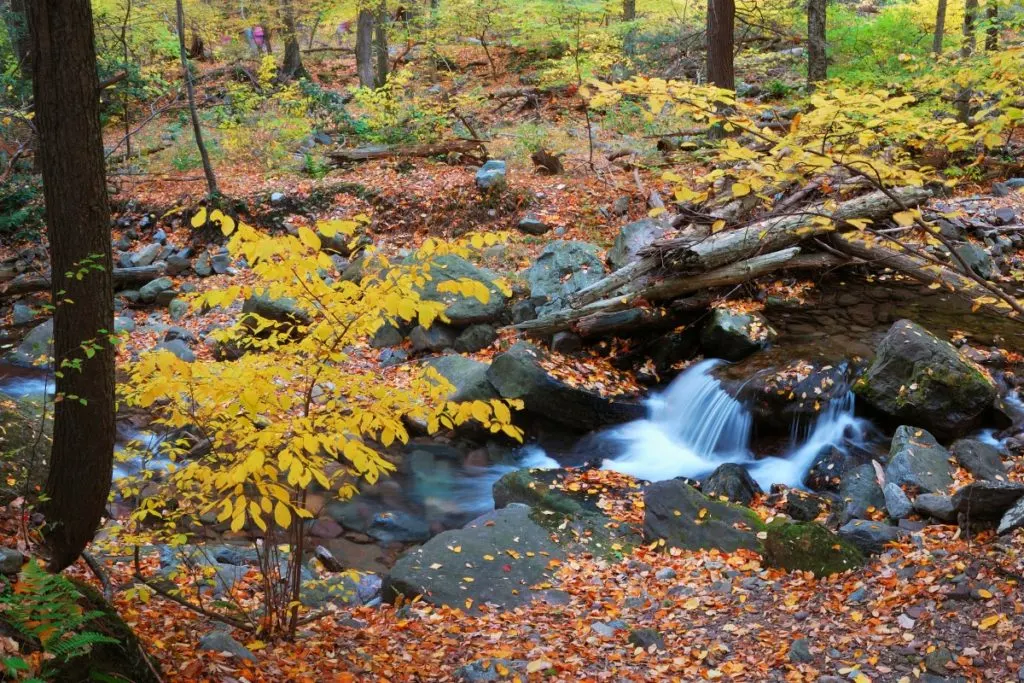As an Amazon Associate, I earn from qualifying purchases with no additional costs for you.
Rockhounding in Delaware has its ups and downs as there aren’t many types of minerals and cool rocks. Delaware isn’t as popular for rockhounding as other U.S. states, however, there are certain fascinating specimens to be found.
In Delaware, you can find sillimanite, quartz crystals (Cape May Diamonds), garnet, mica, feldspar, belemnite fossils, Miocene fossils, beryl, or Pleistocene fossils, among other things. Some of the best rockhounding spots in Delaware are around the Piedmont region in the north, or the beaches near Cape Henlopen.
Rockhounding in Delaware has its rewards if you know where to look for it. Let’s examine this state and see exactly what you can find, and where!

If you are interested in checking out the best rockhounding book about rockhounding in New Hampshire you can find it by clicking here (Amazon link).
Best Rockhounding Sites & Beaches in Delaware
The best rockhounding sites and beaches in Delaware include Cape Henlopen, Laurel, Hoopes Reservoir, Deauville Beach, Fowler Beach, Chesapeake & Delaware Canal, Woodlawn, Pepper Creek, Coursey Pond, Kilen Pond, Brandywine Springs State Park, St. Georges, and the northern parts of the Piedmont region and the south beaches.
Out of the sites listed, the Woodlawn Quarry is a fascinating location just to explore and witness several minerals, rocks, and crystals, however, the collection is prohibited. When it comes to the Brandywine Springs State Park, you may collect outside park boundaries. Let’s see what you can find in some of the most popular rockhounding sites in Delaware!
Cape Henlopen
Once you reach Cape Henlopen, in Delaware, if you head out on both sides of the beach, you may find quartz crystals, known as Cape May Diamonds.
These quartz pebbles are named after the many specimens found on the beaches of Cape May Point, New Jersey, but they can be found in other places as well. If you do some beachcombing, you might find some other things to collect, such as shark teeth or sea glass.
Hoopes Reservoir
The Hoopes Reservoir in Delaware, among a few other places, is where enthusiasts can find the coveted sillimanite mineral. Named after Benjamin Silliman, an American chemist, the beautiful mineral was first described in 1824. It is an aluminosilicate polymorph, such as andalusite and kyanite.
Chesapeake & Delaware Canal
If you find your way to the Chesapeake & Delaware Canal, you should definitely search the sands on the eastern parts of St. Georges. There, rockhounds may find various fossils, belemnites, clamshells, and oyster shells.
Pepper Creek
Just south of Dagsboro, Pepper Creek in Delaware is among the best rockhounding locations to find marine fossils and Pleistocene fossils.
The Pleistocene epoch lasted from about 2.6 million years ago and ended 11,700 years ago. One of the largest discovered fossils belonging to this epoch is that of the mammoth.
TIP: While it’s true that Delaware is a small state, it’s certainly not lacking in valuable rocks and minerals. Check out the common rocks and minerals in Delaware in the article below:
10 Common Rocks & Minerals You Can Find in Delaware
Kilen Pond
The Kilen Pond in Delaware is an excellent place to find Miocene fossils. The Miocene Epoch occurred from 23.03 million years, to 5.3 million years ago.
Characterized by a warmer global climate, fossils belonging to the Miocene Epoch are diversified, as it includes shark teeth, and vertebrate fossils, such as those of rhinos, giant camels, sheep-like oreodonts, and many others.
BTW: Do you want to know more about rock and mineral identification? The books listed below are the best ones you can find on the internet (Amazon links):
- Smithsonian Handbooks: Rocks & Minerals
- Gemstone & Crystal Properties (Quick Study Home)
- Ultimate Explorer Field Guide: Rocks and Minerals (National Geographic Kids)
Rocks and Minerals Found in Delaware

The Red Clay Valley in Delaware contains some of the most diversified rocks in the state, such as igneous, sedimentary, and metamorphic rocks. You can find basalt, granite, gabbro, pegmatite, diorite, gneiss, schist, amphibolite, serpentine, quartzite, marble, shale, sandstone, conglomerate, or limestone.
Many rockhounds are interested in finding geodes in Delaware, and a couple of them try their luck in the Piedmont region. However, there haven’t been any recorded discoveries of geodes in Delaware.
When it comes to minerals in Delaware, although the state lacks diversity and there are few places you can search, there are a couple of specimens worth looking for.
In Delaware, you can find minerals such as quartz, feldspar, mica, garnet (almandine), sillimanite, calcite, dolomite, serpentine, amphibole, pyroxene, pyrite, and gold, among others.
| Mineral | Location |
|---|---|
| Sillimanite | Hoopes Reservoir, Brandywine Springs State Park |
| Garnet (Almandine) | Woodlawn Quarry |
If you want to find sillimanite minerals in Delaware, your best luck is the Hoopes Reservoir and the Brandywine Springs State Park. When searching for the mineral, make sure you are doing so outside the park boundaries to avoid breaking the law.
When it comes to finding gold in Delaware, things get tricky. Delaware is ranked among the poorest states in mineral resources, and this includes gold, but it doesn’t mean it doesn’t exist.
The biggest chance of finding gold in Delaware is in the Red Clay Valley, or the regions where metamorphic rocks are present since they may contain lode deposits.
Almandine garnet specimens have been discovered in Delaware. One popular location where they can be found in the Woodlawn Quarry. Unfortunately for rockhounds, the quarry prohibits collecting.
TIP: If you want to know more about gold prospecting in Delaware, check out the complete guide in the article below:
Gold Prospecting in Delaware: 3 Best Locations & Laws
Finding Crystals in Delaware
Crystals are even rarer than minerals in Delaware. Most of the crystals that you can find are quartz crystals.
Some of the best places to try and find crystals in Delaware include Cape Henlopen, Deauville Beach, Fowler Beach, and in general, the beaches in the southern parts of the state. Cape May Diamonds are usually found in these areas.
Where to Find Sea Glass in Delaware?
Sea Glass is fairly common on the beaches of Delaware. You can find some beautiful sea glass specimens in Cape Henlopen, but you will have competition.
You can also try your luck at Pickering Beach, Bowers Beach, Big Stone Beach, or the Delaware Seashore State Park. The best time to find sea glass is in the early hours so you can avoid the crowds.
Where to Find Fossils in Delaware?
Although the state of Delaware doesn’t contain many minerals, gemstones, or crystals, it does shine when it comes to fossils. In Delaware, you can find fossils belonging to the Pleistocene and Miocene epochs.
Pleistocene epoch fossils are commonly found in Pepper Creek, just south of Dagsboro. Miocene epoch fossils in Delaware can be found at Coursey Pond or Kilen Pond. To find the much-coveted belemnites fossils, you should head towards the Chesapeake & Delaware Canal, and search for them in the sands east of St. Georges.
Some of the fossils that you can find in Delaware include shark teeth, belemnites, ammonite, nautilus, gastropods, mosasaurs, plesiosaurs, and other dinosaurs fossils, marine fossils, and vertebrate fossils.
Bethany Beach is a popular location for those that wish to find shark teeth. Some megalodon teeth were found in the Patuxent River. The Pollack Farm is another popular place where shark fossils were discovered, alongside arthropods, large vertebrates, small insects, and other Miocene fossils.
Finding relics and other artifacts such as arrowheads in Delaware is also possible. The Iron Hill area just south of Newark, northwestern Delaware, is a popular place where jasper items and arrowheads were found. The Delaware Bay and the Chesapeake Bay are also potential places where the Paleo-Indians might have hunted.
Generally, large water bodies, such as rivers, creeks, and other places where animals gather are the best places to search for arrowheads.
TIP: Alluvial deposits along rivers are brilliant places to go rockhounding. Check out the best tips on finding gemstones in rivers and creeks in the article below:
8 Tips On Finding Gemstones In Nature (Rivers & Creeks)
FAQs About Rockhounding in Delaware
Still did not find the answer to your answers about rockhounding in Delaware? Find frequently asked questions in the section below:
What is the State Mineral of Delaware?
The official state mineral of Delaware is the sillimanite, since 1977. It is an aluminum silicate that manifests itself in high-temperature and aluminum-rich metamorphic rocks. It is a member of the polymorph family, alongside kyanite and andalusite. The schists of Delaware Piedmont are popular places where sillimanite is present.
What is the State Fossil of Delaware?
The official state fossil of Delaware is belemnite, since 1996. The belemnite was a squid-like creature with a conical shell. It is part of the phylum Mollusca order, alongside other members such as clams, octopuses, and squids. Though belemnite is extinct, fossils can be found throughout the Chesapeake and Delaware Canals.
Conclusion
The state of Delaware is poor when it comes to mineral resources, crystals, and gemstones. Although it does have its fair share of diversity when it comes to rocks in certain areas, the state shines in its fossil diversity.
In Delaware, some of the most sought-after specimens include the Sillimanite mineral, the Cape May Diamonds (quartz crystals), belemnite fossils, Miocene fossils, and Pleiocene fossils.
Although it is the second smallest state in the U.S., and its reputation might deter rockhounds from scavenging specimens, Delaware has its own fair share of beauty and things to collect.
TIP: And it’s rockhounding time now! But do you know what tools you need for rockhounding? Check out the list of all needed tools and equipment for rockhounding in the article below:
The Complete Guide: All Tools You Need for Rockhounding
